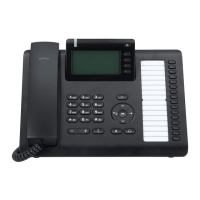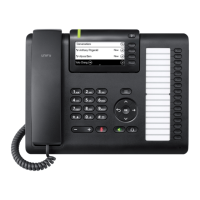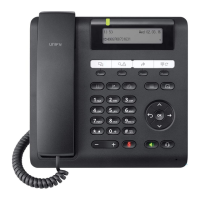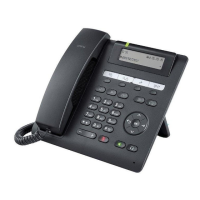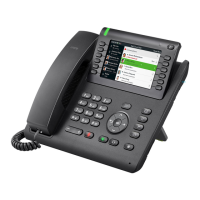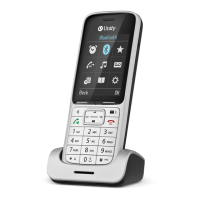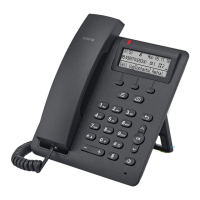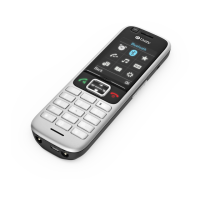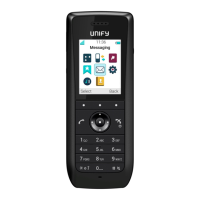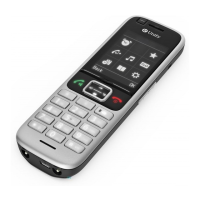Do you have a question about the Unify OpenScape CP400 and is the answer not in the manual?
Explains symbols used in the manual.
Instructions for software updates.
Guidelines for maintaining the phone.
Links to additional information.
Provides an overview of the manual's content and purpose.
Describes how selected actions are illustrated.
Details shown for a selected conversation.
Identifies and explains phone controls and displays.
Explains the function of softkeys.
Details about audio keys and volume controls.
Explains the use of mode keys.
How to enter numbers using the dial pad.
How to enter text using the dial pad.
How to perform actions using softkeys.
How to navigate through phone menus.
How to access context-sensitive menus.
Describes the phone's interface during calls.
How incoming calls are signaled and handled.
Handling multiple simultaneous incoming calls.
Navigating user settings via menus.
How to activate/deactivate functions using switches.
Adjusting display settings like brightness.
How to adjust the physical tilt of the display.
Customizing screen brightness.
How to enable the idle screen saver.
Configuring the idle screen display type.
Adjusting various volume settings.
Setting the ringer volume.
Managing call waiting.
Information about central speed dial numbers.
How to assign functions to keys.
How to answer incoming calls.
Answering calls using the handset.
Answering calls using the speakerphone.
Answering calls using a headset.
Making calls with the handset off the hook.
Making calls with the handset on the hook.
Making calls using a headset.
Using central speed dial numbers.
Using individual speed dial numbers.
Switching to speakerphone during a call.
Switching to the handset during a call.
Allowing others to listen to a call.
Setting up and using line keys.
Explanation of the primary line.
Explanation of secondary lines.
Usage of private lines.
Usage of shared lines.
Usage of direct call lines.
How to activate the preview function.
How to deactivate the preview function.
Accepting calls based on order.
Answering prioritized calls.
How to activate call transfer.
Dialing with automatic line seizure.
Dialing with selectable line seizure.
Holding calls on line keys.
Holding and reaccepting calls.
Exclusive hold and reacceptance.
How to retrieve messages from the line mailbox.
How to perform a callback request.
How to delete mailbox entries.
How to end a mailbox query.
How to allow entry to a line.
How to park a call on the first phone.
How to continue a call on the second phone.
Setting up appointment reminders.
How to save appointments.
How to delete saved appointments.
Explains Basic and Data Privacy mobility variants.
Details on Basic mobility variant.
Details on Data Privacy mobility variant.
Logging off the guest phone.
Logging off via the home phone.
Initiating speaker calls to a variable destination.
Initiating group speaker calls to variable destinations.
Initiating group speaker calls to target destinations.
Saving destinations and activating call forwarding.
Setting up and activating the door opener.
Opening the door without a call.
How to activate/deactivate Do Not Disturb.
Locking the phone within the system.
Unlocking the phone from the system.
Locking the phone locally.
Checking secure call status when idle.
Checking secure call status during a call.
Information regarding secure calls.
Adjusting audio settings like volume.
Setting different volume levels.
Selecting and configuring call types for ringtones.
How to reset user data to factory settings.
General information about the web interface.
Steps to access the web interface.
Information on EULA and Open Source licenses.
Accessing administrator settings via the web.
Troubleshooting error messages shown on the display.
Troubleshooting unresponsive keys.
Troubleshooting ring issues.
General troubleshooting steps.
Explains symbols used in the manual.
Instructions for software updates.
Guidelines for maintaining the phone.
Links to additional information.
Provides an overview of the manual's content and purpose.
Describes how selected actions are illustrated.
Details shown for a selected conversation.
Identifies and explains phone controls and displays.
Explains the function of softkeys.
Details about audio keys and volume controls.
Explains the use of mode keys.
How to enter numbers using the dial pad.
How to enter text using the dial pad.
How to perform actions using softkeys.
How to navigate through phone menus.
How to access context-sensitive menus.
Describes the phone's interface during calls.
How incoming calls are signaled and handled.
Handling multiple simultaneous incoming calls.
Navigating user settings via menus.
How to activate/deactivate functions using switches.
Adjusting display settings like brightness.
How to adjust the physical tilt of the display.
Customizing screen brightness.
How to enable the idle screen saver.
Configuring the idle screen display type.
Adjusting various volume settings.
Setting the ringer volume.
Managing call waiting.
Information about central speed dial numbers.
How to assign functions to keys.
How to answer incoming calls.
Answering calls using the handset.
Answering calls using the speakerphone.
Answering calls using a headset.
Making calls with the handset off the hook.
Making calls with the handset on the hook.
Making calls using a headset.
Using central speed dial numbers.
Using individual speed dial numbers.
Switching to speakerphone during a call.
Switching to the handset during a call.
Allowing others to listen to a call.
Setting up and using line keys.
Explanation of the primary line.
Explanation of secondary lines.
Usage of private lines.
Usage of shared lines.
Usage of direct call lines.
How to activate the preview function.
How to deactivate the preview function.
Accepting calls based on order.
Answering prioritized calls.
How to activate call transfer.
Dialing with automatic line seizure.
Dialing with selectable line seizure.
Holding calls on line keys.
Holding and reaccepting calls.
Exclusive hold and reacceptance.
How to retrieve messages from the line mailbox.
How to perform a callback request.
How to delete mailbox entries.
How to end a mailbox query.
How to allow entry to a line.
How to park a call on the first phone.
How to continue a call on the second phone.
Setting up appointment reminders.
How to save appointments.
How to delete saved appointments.
Explains Basic and Data Privacy mobility variants.
Details on Basic mobility variant.
Details on Data Privacy mobility variant.
Logging off the guest phone.
Logging off via the home phone.
Initiating speaker calls to a variable destination.
Initiating group speaker calls to variable destinations.
Initiating group speaker calls to target destinations.
Saving destinations and activating call forwarding.
Setting up and activating the door opener.
Opening the door without a call.
How to activate/deactivate Do Not Disturb.
Locking the phone within the system.
Unlocking the phone from the system.
Locking the phone locally.
Checking secure call status when idle.
Checking secure call status during a call.
Information regarding secure calls.
Adjusting audio settings like volume.
Setting different volume levels.
Selecting and configuring call types for ringtones.
How to reset user data to factory settings.
General information about the web interface.
Steps to access the web interface.
Information on EULA and Open Source licenses.
Accessing administrator settings via the web.
Troubleshooting error messages shown on the display.
Troubleshooting unresponsive keys.
Troubleshooting ring issues.
General troubleshooting steps.
| Handset type | Wired handset |
|---|---|
| Product type | IP Phone |
| Product color | Black |
| Display diagonal | 3.7 \ |
| Backlight display | Yes |
| Display resolution | 240 x 120 pixels |
| Volume control | Buttons |
| Number of programmable keys | 16 |
| Caller ID | - |
| Lines quantity | - lines |
| Phonebook capacity | 1000 entries |
| Security algorithms | 128-bit AES, 256-bit AES, HTTPS |
| Networking standards | IEEE 802.3az |
| Ethernet LAN data rates | 10, 100, 1000 Mbit/s |
| Ethernet LAN interface type | Gigabit Ethernet |
| Supported network protocols | IP v4/v6 (SIP) IPv4 (HFA), DHCP, |
| Number of handles included | - pc(s) |
| Operating system installed | Linux |
| Ringer type | MP3 |
| Voice codecs | G.711, G.722, G.729, G.729A, G.729B |
| Safety | CISPR22 Class B, CISPR 24 EN55032 Class B, EN55024 FCC Part 15 (CFR 47) Class B |
| Certification | CE NRTL FCC Part 68 (CFR 47) / CS-03 Part V |
| Storage temperature (T-T) | -40 - 70 °C |
| Operating temperature (T-T) | 5 - 70 °C |
| Headset connectivity | DHSG/EHS |
| Harmonized System (HS) code | 85171800 |
| Depth | 165 mm |
|---|---|
| Width | 283 mm |
| Height | 143 mm |
| Weight | 1200 g |
